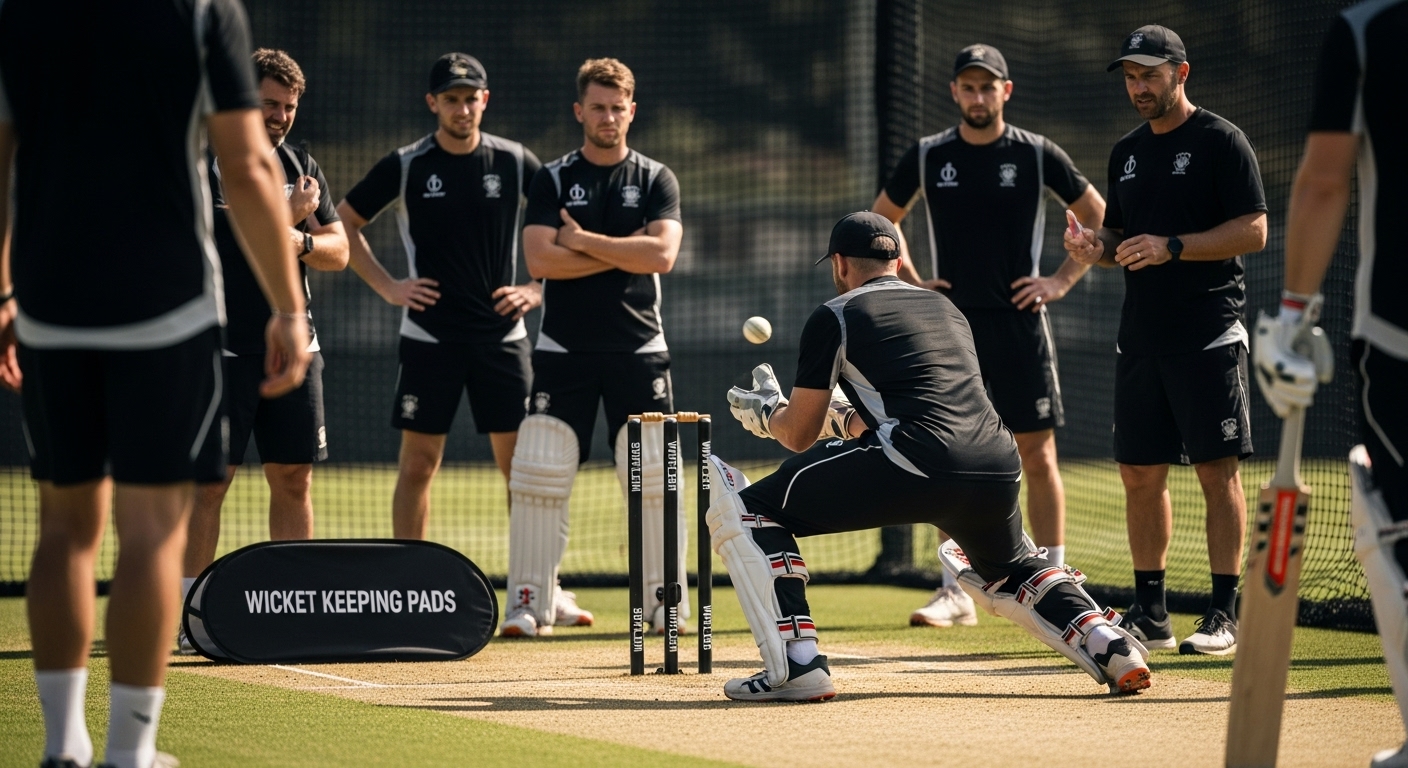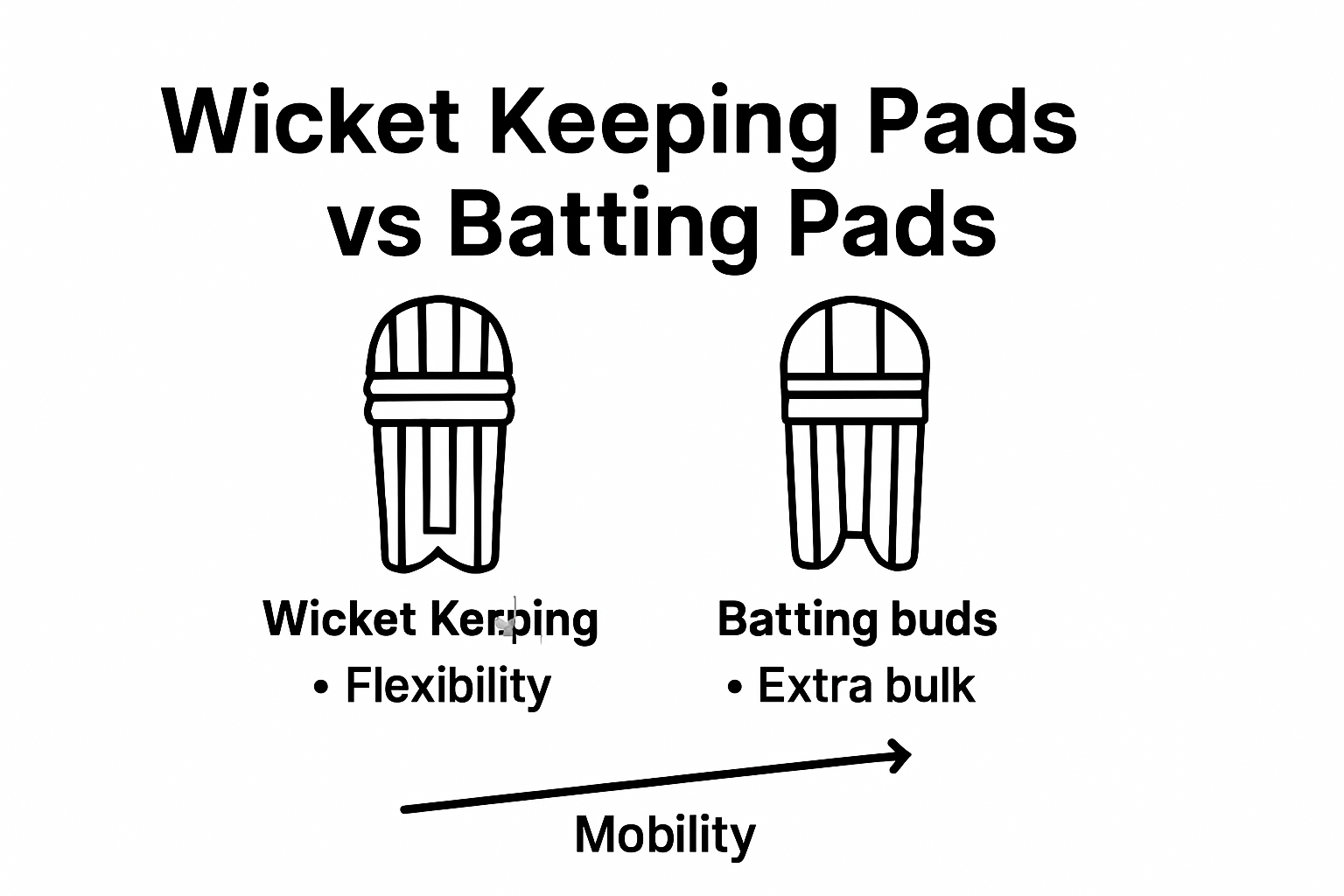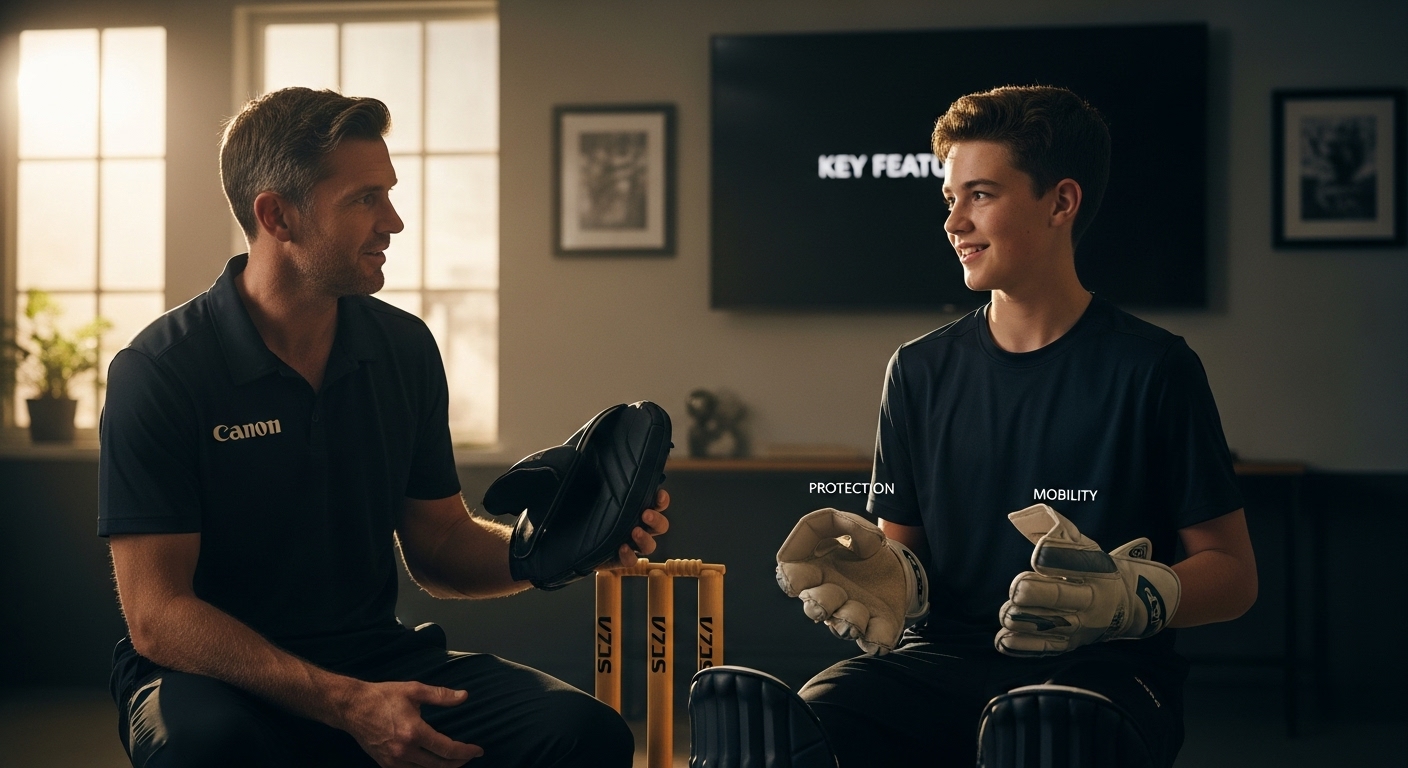Understanding What Are Wicket Keeping Pads

Cricket is a game where tiny details can make a huge difference and wicket keeping pads are one of those pieces of equipment that quietly decide how confidently a player stands behind the stumps. You might think all leg guards are basically the same but that could not be further from the truth. A cricket ball can slam into a wicket keeper at speeds over 90 miles per hour and modern pads use advanced materials to dramatically cut injury risk so picking the right one transforms not only your safety but your whole game strategy.
Table of Contents
- Defining Wicket Keeping Pads: What They Are
- The Purpose of Wicket Keeping Pads in Cricket
- Key Features and Components of Wicket Keeping Pads
- How Wicket Keeping Pads Protect Players
- Choosing the Right Wicket Keeping Pads for Performance
Quick Summary
| Takeaway | Explanation |
|---|---|
| Wicket keeping pads protect legs from ball impacts. | These specialized pads absorb shock to shield wicket keepers’ legs from high-speed cricket balls. |
| Designed for mobility without sacrificing safety. | Wicket keeping pads are lightweight and flexible, allowing quick movements while ensuring comprehensive protection. |
| Choose pads based on fit and individual comfort. | The right fit allows unrestricted movement and confidence, essential for performance during matches. |
| Advanced materials enhance protection and performance. | Modern pads use cutting-edge materials for optimal shock absorption and breathability while reducing weight. |
| Strategic design features support natural movement. | Anatomically shaped pads provide a snug fit and reduce interference with the wicket keeper’s agility during play. |
Defining Wicket Keeping Pads: What They Are
Wicket keeping pads represent specialized protective equipment crucial in cricket, designed specifically to shield a wicket keeper’s legs from potential ball impacts during matches. Unlike batting pads, these uniquely engineered protective gear items serve a distinctive purpose in safeguarding players positioned behind the wickets.
To help readers clearly understand the differences between wicket keeping pads and batting pads as described in the article, the following table compares their key features and intended uses.
| Feature | Wicket Keeping Pads | Batting Pads |
|---|---|---|
| Primary Purpose | Protect legs during wicket keeping | Protect legs while batting |
| Weight | Lightweight | Heavier |
| Flexibility | High (to allow quick movement) | Lower (emphasis on impact protection) |
| Design Shape | Contoured for mobility | Bulkier, with broader ankle and knee coverage |
| Protective Coverage | Focuses on front and sides of the leg | Covers entire front, sometimes wider sides |
| Material Composition | High-density foam, synthetic fabrics | Similar, but with more layers and bulk |
| Use Scenario | For players behind the wickets | For batters facing bowlers |
The Fundamental Purpose of Wicket Keeping Pads
Wicket keeping pads are technical protective garments crafted to absorb and disperse the kinetic energy generated when a cricket ball strikes a player’s legs. According to research published in the journal Polymers, these pads are engineered with advanced materials that minimize injury risks during intense cricket gameplay.
The primary functions of wicket keeping pads include:
- Providing comprehensive leg protection from high-speed ball impacts
- Absorbing shock and reducing potential injury risks
- Offering flexibility for rapid movement behind the wickets
- Maintaining player safety without compromising mobility
Construction and Design Characteristics
Typically constructed from robust materials like high-density foam, reinforced synthetic fabrics, and protective padding, wicket keeping pads differ significantly from standard batting pads. They are designed to be lighter, more flexible, and provide enhanced mobility for wicket keepers who must react swiftly to incoming balls.

Key design elements include strategically placed protective zones, breathable fabric panels, and contoured shapes that conform closely to the keeper’s leg anatomy. These technical considerations ensure maximum protection while allowing unrestricted movement during critical match moments.
This table breaks down the major components and ergonomic features of wicket keeping pads discussed throughout the article, providing a quick at-a-glance summary of their functional roles.
| Component / Feature | Description / Function |
|---|---|
| High-Density Foam | Absorbs and disperses impact from cricket ball strikes |
| Reinforced Synthetic Fabrics | Adds durability and resistance to wear |
| Lightweight Protective Polymers | Reduces overall weight for greater mobility |
| Breathable Textiles | Manages heat and moisture for player comfort |
| Anatomical Padding | Follows leg curvature to maximize protection and fit |
| Adjustable Strapping System | Ensures personalized, secure attachment to legs |
| Ventilated Panels | Improves airflow and reduces internal pad temperature |
| Articulated Joints | Allows for natural joint movement and flexibility |
Understanding the specialized nature of wicket keeping pads reveals their critical role in cricket safety, transforming them from mere equipment to essential protective gear that enables players to perform with confidence and security.
The Purpose of Wicket Keeping Pads in Cricket
In the dynamic world of cricket, wicket keeping pads serve a critical protective function that goes far beyond simple equipment. These specialized protective gear items are engineered to shield wicket keepers from potential serious injuries during high-intensity match scenarios.
Injury Prevention and Physical Protection
According to Encyclopædia Britannica’s sports research, wicket keeping pads are fundamental in preventing leg injuries caused by high-velocity cricket balls. A cricket ball traveling at speeds exceeding 90 miles per hour can generate substantial impact force, making comprehensive leg protection absolutely essential for wicket keepers.
The primary protective objectives include:
- Absorbing direct ball impacts to prevent bruising and potential fractures
- Distributing kinetic energy across a broader surface area
- Creating a barrier between the hard cricket ball and vulnerable leg regions
- Enabling wicket keepers to maintain confident positioning without fear of injury
Performance and Mobility Considerations
Wicket keeping pads are not merely defensive equipment but also precision-engineered tools that support athletic performance. Modern pad designs balance robust protection with remarkable flexibility, allowing wicket keepers to execute rapid movements such as quick lateral shifts, sudden squats, and instantaneous diving actions.
These pads are strategically constructed to minimize movement restrictions while providing comprehensive leg coverage. Advanced material technologies enable wicket keepers to maintain optimal agility, ensuring they can respond instantaneously to balls traveling at extreme speeds without compromising their protective shield.
Ultimately, wicket keeping pads represent a sophisticated intersection of safety engineering and athletic performance, transforming potential injury risks into opportunities for confident, dynamic cricket gameplay.
Key Features and Components of Wicket Keeping Pads
Wicket keeping pads are sophisticated pieces of protective cricket equipment designed with intricate engineering principles to provide maximum safety and performance for players. These specialized protective items combine advanced materials and strategic design elements to create comprehensive leg protection.
Material Composition and Structural Design
According to materials research published in scientific journals, wicket keeping pads utilize cutting-edge composite materials engineered for superior impact absorption. The primary components typically include:
- High-density foam layers for shock dispersion
- Reinforced synthetic fabrics for durability
- Lightweight protective polymers
- Breathable moisture-wicking textiles
The structural integrity of wicket keeping pads relies on precision engineering that balances protection with flexibility. Each pad is meticulously constructed to provide comprehensive leg coverage while maintaining the wicket keeper’s ability to move rapidly and respond to incoming balls.
Ergonomic Features and Performance Considerations
Modern wicket keeping pads incorporate sophisticated ergonomic design principles that extend beyond basic protection. Strategic padding placement, contoured shapes, and articulated joints allow players to maintain natural leg movement while ensuring complete safety.
Key ergonomic elements include:
- Anatomically designed padding that follows leg curvature
- Adjustable strapping systems for personalized fit
- Ventilated panels to manage heat and moisture
- Lightweight construction to minimize player fatigue
These technical considerations transform wicket keeping pads from simple protective gear into precision athletic equipment that supports optimal performance and player confidence during high-intensity cricket matches.

How Wicket Keeping Pads Protect Players
Wicket keeping pads represent a sophisticated protective system designed to shield cricket players from potentially devastating ball impacts. These specialized protective garments function as a critical defensive mechanism that transforms potential injury risks into manageable physical interactions.
Shock Absorption and Impact Mitigation
According to research published in the Journal of Sports Science & Medicine, wicket keeping pads utilize advanced materials engineered to absorb and disperse kinetic energy generated during ball impacts. The complex layering of protective materials creates a multi-stage energy absorption mechanism that significantly reduces the force transmitted to a player’s legs.
The primary protective mechanisms include:
- Distributing impact forces across a wider surface area
- Preventing direct contact between the cricket ball and skin
- Reducing peak deceleration forces during ball strikes
- Minimizing potential tissue damage and bruising
Biomechanical Protection Strategies
Wicket keeping pads are meticulously designed to provide comprehensive leg protection while maintaining crucial athletic mobility. The strategic placement of protective zones allows players to maintain natural movement patterns while ensuring robust physical defense.
Key biomechanical protection strategies involve:
- Conforming to leg anatomy for maximum coverage
- Creating flexible protective zones around vulnerable joints
- Implementing graduated density padding for targeted protection
- Enabling rapid movement without compromising safety
These technical innovations transform wicket keeping pads from simple protective equipment into sophisticated safety systems that enable players to perform with confidence and security during high-intensity cricket matches.
Choosing the Right Wicket Keeping Pads for Performance
Selecting appropriate wicket keeping pads involves a complex interplay of performance, protection, and personal comfort. These specialized protective items require careful consideration to ensure they enhance rather than hinder a player’s athletic capabilities.
Biomechanical Fit and Movement Considerations
Research from the Journal of Sports Sciences demonstrates that wicket keeping pads significantly impact player movement. The right pads must balance comprehensive protection with minimal performance restriction, enabling wicket keepers to maintain agile positioning and rapid reactive movements.
Critical fit considerations include:
- Ensuring unrestricted ankle and knee joint mobility
- Matching pad dimensions to individual leg proportions
- Minimizing additional weight that could impede movement
- Providing consistent coverage without compromising flexibility
Material Selection and Performance Optimization
Advanced material technologies play a crucial role in modern wicket keeping pad design. The ideal pad combines lightweight construction with superior impact absorption, utilizing sophisticated composite materials that distribute kinetic energy effectively.
Key performance-focused selection criteria involve:
- Evaluating shock absorption capabilities
- Assessing breathability and moisture management
- Comparing different protective material compositions
- Analyzing pad weight and its potential movement implications
Ultimately, selecting the right wicket keeping pads transcends simple protective gear selection. It represents a strategic decision that directly influences a player’s confidence, safety, and potential performance during high-intensity cricket matches.
Upgrade Your Wicket Keeping Protection with CricketKingdom
Do you worry about staying agile behind the stumps without sacrificing your safety? If you have read about the critical role of wicket keeping pads and wondered how to get the right fit for lasting comfort and confidence, now is the perfect time to act. The article highlighted how advanced materials and precise sizing make all the difference between mobility and risk—qualities you will find in our hand-selected range.

Choose professionally engineered wicket keeping pads that deliver superior shock absorption, lightweight movement, and long-lasting durability. Visit CricketKingdom.co.uk to discover products designed for players who demand both protection and performance. With free shipping for orders over £100 and expert customer support, there has never been a better moment to secure your perfect gear. Shop now to protect your game and play with total peace of mind.
Frequently Asked Questions
What are wicket keeping pads designed for?
Wicket keeping pads are specialized protective equipment designed to shield a wicket keeper’s legs from impacts during cricket matches, providing crucial protection against high-speed balls.
How do wicket keeping pads differ from batting pads?
Unlike batting pads, which are bulkier and designed for batters, wicket keeping pads are lighter and more flexible to allow for quick movements behind the wickets while still offering essential leg protection.
What materials are used in the construction of wicket keeping pads?
Wicket keeping pads are typically constructed from high-density foam, reinforced synthetic fabrics, lightweight protective polymers, and moisture-wicking textiles to ensure durability and comfort.
How do I choose the right wicket keeping pads for my needs?
When choosing wicket keeping pads, consider the fit for mobility, the weight of the pads, and the materials used for shock absorption. It’s essential to ensure they allow for unrestricted movement while providing adequate protection.
Recommended
- The Role of Grip and Handle in Bat Performance
- The Evolution of Cricket Bat Designs | The Cricket Kingdom
- Kookaburra Ghost 6.3 Cricket Bat – SH – The Cricket Kingdom
- Kookaburra Kahuna 6.3 Cricket Bat – sh – The Cricket Kingdom


